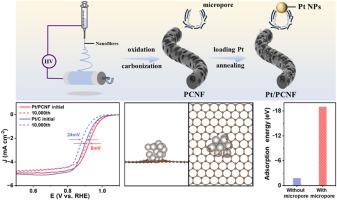Micropore-confined ultrafine Pt nanoparticles in hierarchical porous carbon nanofibers for pH-universal oxygen reduction with enhanced stability
IF 11.6
2区 材料科学
Q1 CHEMISTRY, PHYSICAL
引用次数: 0
Abstract
Carbon-supported platinum (Pt/C) is the most extensively used electrocatalyst for the oxygen reduction reaction (ORR). However, the electrochemical degradation occurring during operation severely restricts the catalyst's cycling stability, posing a critical obstacle for practical commercialization. Here, we developed a high-performance alternative electrocatalyst consisting of ultrafine Pt nanoparticles embedded in hierarchical porous carbon nanofibers (Pt/PCNF). Importantly, we elucidate a novel micropore confinement effect, demonstrating through DFT calculations that micropores serve as high-surface-area anchoring sites for Pt species, effectively stabilizing them. This unique architecture facilitates ultrahigh Pt dispersion, endowing the catalytic with exceptional stability for pH-universal ORR. Remarkably, the Pt/PCNF catalyst achieves 70 % higher electrochemically active surface area than commercial Pt/C while maintaining 99.4 % of its initial activity after 10,000 durability cycles. Furthermore, when integrated into Zn-air batteries, the catalyst delivers a high open-circuit voltage (1.42 V) and remarkable peak power density (216.73 mW cm−2). This work provides fundamental insights into the stabilization mechanisms of Pt-based ORR catalysts through micropore confinement, while demonstrating exceptional performance metrics that meet industrial requirements for fuel cell applications.

微孔约束的超细铂纳米颗粒在分级多孔碳纳米纤维中用于pH-universal氧还原,具有增强的稳定性
碳负载铂(Pt/C)是氧还原反应(ORR)中应用最广泛的电催化剂。然而,在使用过程中发生的电化学降解严重限制了催化剂的循环稳定性,成为实际商业化的关键障碍。在这里,我们开发了一种高性能的替代电催化剂,由嵌入分层多孔碳纳米纤维(Pt/PCNF)的超细铂纳米颗粒组成。重要的是,我们阐明了一种新的微孔限制效应,通过DFT计算证明了微孔作为Pt物种的高表面积锚定位点,有效地稳定了它们。这种独特的结构有利于超高铂分散,使催化剂具有特殊的ph -通用ORR稳定性。值得注意的是,Pt/PCNF催化剂的电化学活性表面积比商用Pt/C高70%,在10,000次耐久性循环后仍保持99.4%的初始活性。此外,当集成到锌空气电池中时,催化剂提供了高开路电压(1.42 V)和显著的峰值功率密度(216.73 mW cm−2)。这项工作通过微孔限制为基于pt的ORR催化剂的稳定机制提供了基本的见解,同时展示了满足燃料电池应用工业要求的卓越性能指标。
本文章由计算机程序翻译,如有差异,请以英文原文为准。
求助全文
约1分钟内获得全文
求助全文
来源期刊

Carbon
工程技术-材料科学:综合
CiteScore
20.80
自引率
7.30%
发文量
0
审稿时长
23 days
期刊介绍:
The journal Carbon is an international multidisciplinary forum for communicating scientific advances in the field of carbon materials. It reports new findings related to the formation, structure, properties, behaviors, and technological applications of carbons. Carbons are a broad class of ordered or disordered solid phases composed primarily of elemental carbon, including but not limited to carbon black, carbon fibers and filaments, carbon nanotubes, diamond and diamond-like carbon, fullerenes, glassy carbon, graphite, graphene, graphene-oxide, porous carbons, pyrolytic carbon, and other sp2 and non-sp2 hybridized carbon systems. Carbon is the companion title to the open access journal Carbon Trends. Relevant application areas for carbon materials include biology and medicine, catalysis, electronic, optoelectronic, spintronic, high-frequency, and photonic devices, energy storage and conversion systems, environmental applications and water treatment, smart materials and systems, and structural and thermal applications.
 求助内容:
求助内容: 应助结果提醒方式:
应助结果提醒方式:


